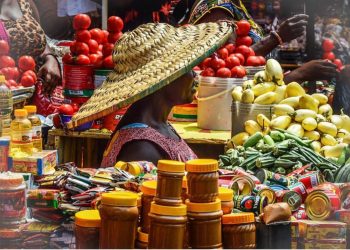Ghana’s year-on-year inflation tumbles for the second consecutive month to 52.8% after dropping from 54.1% in December 2022 to 53.6% in January 2023.
According to the Consumer Price Index(CPI) release from the Ghana Statistical Service, the general price level for February 2023 exceeded what was recorded in same period last year, 2022.
The year-on-year inflation for February 2022 stood at 15.7% skyrocketing to 52.8% in February 2023, showing a great and rather abnormal surge in the general prices of goods and services for a year period.
This shows that inflation for a year period soared by 37.1%, which reflects the crippling state of the Ghanaian economy and the extent to which prices of commodities have appreciated in just a year.
Month-on-month inflation between January 2023 and February 2023 stood at 1.9%, increasing by 0.2 percentage points from 1.7% recorded for the month of January.

The month-on-month CPI continues its upward trend, soaring to 168.7 in February 2023 from 165.6 recorded in the past month. On the other hand, the year-on-year CPI for February reveals CPI has soared by 52.1% from 110.4 in February 2022 to 168.7 in February this year.
The following five (5) divisions led the statistics with the highest year-on-year inflation for the month of February, 2023: transport (70.3%); Furnishings, household equipment (69.8%); Housing, water, electricity, gas and other fuels (69.6%); Personal care, social protection, and miscellaneous services (62.5%) and lastly, food and non-alcoholic beverages (59.1%).
Food and non-food inflation
Disaggregating the overall month’s inflation into its major sub-components, food inflation for February 2023, fell to 59.1% from 61.0% in January,2023 owing to further stabilization of the cedi, which has further resulted in the reduction in the prices of items relative to the fall of 2022 when prices ridiculously surged. The month-on-month food inflation stood at 2.0%.
Hierarchically, fruits and vegetables came top on the list of foods with the highest inflation, with the highest year-on-year of 92.5%, however ranked third with the highest month-to-month inflation in the sub-classes of food, having a month-on-month-inflation rate of 3.7% in the month of February, 2023.

Fish and other sea foods had the lowest year-on-year inflation for the month of February 2023, in the sub-classes of food, with a year-on-year inflation of 61.1%, whereas with a month-on-month inflation of 2.3%.
The overall food inflation recorded soft drinks with the highest year-on-year inflation of 51.4% for February 2023 and cocoa drinks with the lowest, with a year-on-year inflation of 32.4% in that sub-category. On the other leg, water top the list with the overall month-on-month inflation rate with 1.7% whereas fruits and nuts placed lowest with 0.3% month-on-month inflation in that sub-category.

Meanwhile, year-on-year non-food inflation stalls with both January and February 2023 recording 47.9%, with month-on-month non-food inflation at 1.7%.
A closer look at both food and non-food inflation shows the high consumption level of food in Ghana, as opposed to the use of non-food items, thus attracting the highest demand.
Inflation for locally produced goods was 49.0% whereas that for imported items was 62.3%, indicating that the country still has more work to do in terms of cutting down its imports and encourage more domestic production as well as consumption and use of domestically produced items.
Regional inflation
The Western North region recorded the highest inflation for February 2023, followed by the Greater Accra, Bono, Eastern, Central, Savannah, Oti, North East, Bono East, Upper West, Upper East, Western, Northern, Ahafo, Ashanti , Volta regions, with inflation rates of 63.6%, 60.1%, 59.7%, 57.8%, 55.6%, 55.3%, 52.5%, 51.8%, 50.5%, 49.4%, 49.2%, 49.2%, 47.4%, 45.7%, 43.3%, 35.4% correspondingly.
READ ALSO: Debt Restructuring: Four Africa’s Biggest Lenders Plan For $427m Loss In The Financial Industry




















